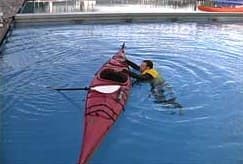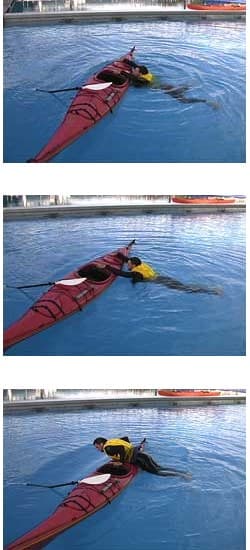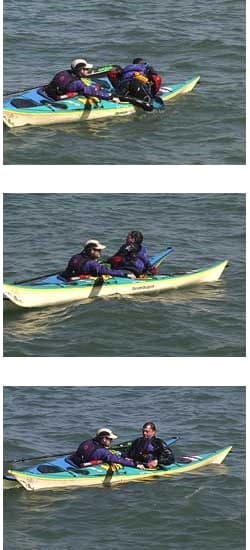Back Deck Re-entry After A Capsize
After a paddler capsizes and chooses to do a wet exit they will have a number of decisions to make before they are in their kayak paddling off into the sunset. One of those decisions is choosing how to get back into the cockpit. There are numerous methods of re-entering ones cockpit depending on the recovery technique chosen. The one I have seen taught and used most often is the back deck re-entry. Just because it is the one used most often does not make it the easiest. Unless a paddler has tried all of the possible re-entry methods they cannot know which one is the easiest. It is up to each paddler to find the re-entry method that works best for them.
Once you have decided that you will climb on the back deck you must position yourself by the back deck facing the kayak. When you first get into position your body will be vertical with your feet straight down and your head up.

The ease of climbing onto the back deck of your kayak is dependent upon the design of your kayak. The greater the height of the the freeboard the higher you will need to left your body out of the water to get onto your back deck. The contour of your back deck is also a factor. A rounded or peaked back deck may mean more work when climbing onto your deck.

Before I recommend some ways of climbing onto the back deck I want to bring your attention to a body position that can occur when a paddler hangs onto the back deck of their kayak. In my experience this body position happens more to females, because of the lower center of gravity in females. This body position has the paddlers legs going under the bottom of the kayak with the feet trying to float up to the surface on the opposite side of the kayak.
I have had some students tell me the air trapped in the feet of their dry suits have been a factor in their bodies assuming this position. Regardless of why ones legs go under the kayak, the paddler needs to return their body back into the vertical position before they try climbing onto the back deck. There is no way a paddler will be able to climb on their back deck with their feet under the hull of the kayak.
If you are strong you can try climbing up starting in the vertical position. You can also try using the buoyancy of your PFD to help you pop out of the water. Instead of just muscling your body up onto the back deck you can sink yourself and use the buoyancy to help you up onto the deck as you pop up.
I have tried this technique a number of times , but it is not my favorite method. When I did try the bouncing method, I tried bouncing a few times so I could sink myself lower into the water so I could get more lift.
When you try to climb onto the back deck from a vertical position, you will using more energy than this next method.
The method most commonly recommended is trying to slide up onto the deck. Instead of starting with your body in the vertical position, the paddler gets their body prone on the surface with their feet on the surface out away from the kayak.
Before you launch yourself onto the back deck you need to have your feet on the surface and your hands firmly holding your grab points on the kayak. The best way to get horizontal is by kicking your feet to the surface behind you.
Once you are ready, give a good kick with your feet as you pull yourself up across your back deck. In addition to pulling with your arms you are also pushing the kayak down. The closer your back deck is to the water the easier it is to slide onto that back deck. Another tip for success is to aim passed your target. All to often paddlers fall short of the target and end up sliding off the deck. This is even more important for woman due to the lower center of gravity. Women need to get more of their body over the deck to keep from sliding back off of the deck.

Once your body is balanced over your back deck you can take a moment to rest. Since getting your body out of the water to reduce immersion time was your first priority, you can now focus on getting your body back into the cockpit.
Even though it is obvious I need to remind those who depend on back deck re-entries NOT to pile a lot of gear on their back decks. I mention the obvious because I have repeatedly seen paddlers over pack for camping trips with numerous dry bags strapped to their back decks. They were not thinking of how they would climb on if they capsized. When I would ask them what they would do if they capsized most of them say, " I didn't think about that when I was packing my kayak." I am not saying not to put gear on you back deck. I am suggesting you think about the implications of putting gear on your back deck if that is your only reliable way of climbing back onto your kayak. Having other re-entry methods gives you options.

One of the concerns in re-entries is the paddler's center of gravity. The lower you keep your center of gravity the less energy your partner has to expend when stabilizing your kayak. That is why lying face down on your kayak is recommended.
When you climbed on to the back deck your body was perpendicular to the kayak. In order to get your body into the cockpit you need to turn your body so it is parallel to the kayak. As you turn your body parallel you look toward your stern as you start putting your feet, one at a time, into the cockpit. Once both feet are in the cockpit you begin to slide your body into the cockpit.
As you slide your body down into the cockpit, while you are face down, there is a point when you need to begin rolling yourself upright. I recommend to my students to rotate up always looking at their support.
Since the back deck re-entry can be used during assisted and solo paddle float recoveries I want the motion to be consistent. If it is assisted it really doesn't make a difference how you rotate up since your partner is stabilizing your kayak. However, if it is a paddle float recovery you are responsible for your balance so watching your paddle float throughout your re-entry is vital. Therefore you have nothing to lose and much to gain if you remember to rotate up while looking at your support.
When you are upright and sitting in your cockpit you will need to situate your spray skirt that probably got wrapped around you when you rotated up in your seat. Your goal should be getting yourself comfortable and your skirt re-attached to the coaming, which makes your kayak the wonderful craft that it is.
As always, you and your partner should be in agreement that the one stabilizing the kayak does not let go until the person depending on that stability clearly says, "You can let go now."
Climbing on your back deck gets more difficult as your back deck gets higher from the water surface. The more gear and clothing you have in front of your torso the harder it is to climb on. Also, be aware of gear on your PFD that can snag on deck lines, rudder lines, hatch buckles (See USK article: "Combat Ready Knife").
As I mentioned above, the more re-entry methods you can reliable perform the more options you will have when conditions get rough. It is important to practice your re-entry methods regularly. I also recommend you include trying your re-entry methods when you are choosing a new kayak.
Pictures seen above were taken from the USK video Capsize Recoveries & Rescue Procedures
Wayne Horodowich, founder of The University of Sea Kayaking (USK), writes monthly articles for the USK web site. In addition, Wayne has produced the popular "In Depth" Instructional Video Series for Sea Kayaking.
Related Articles
Even though they are flipping over, missing their gates and failing their maneuvers, they still look…
Last month we discussed how to detect and patch (not "repair") a leak on a typical roto-molded kayak…
This recovery is an excellent example of using components from two traditional recovery techniques and…
There are two ways of swimming through a rapid. You can swim defensively or offensively. Defensive…


